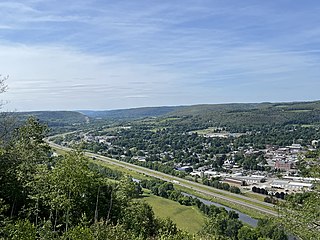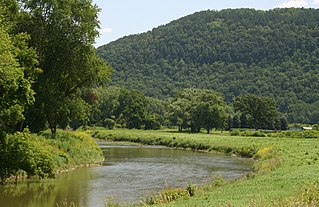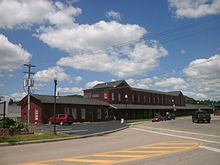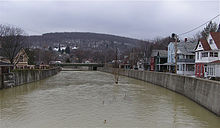
Steuben County (stu-BEN) is a county located in the U.S. state of New York. As of the 2020 census, the population was 93,584. Its county seat is Bath. Its name is in honor of Baron von Steuben, a Prussian general who fought on the American side in the American Revolutionary War, though it is not pronounced the same.

Arkport is a village in Steuben County, New York, United States. It is located in the town of Hornellsville, and is north of the city of Hornell. The population was 844 at the 2010 census. The name comes from the barges used to ship products through the village. The postal code is 14807.
Hornellsville is a town in Steuben County, New York, United States. The population, not counting the city of Hornell, was 4,039 at the 2020 census. The name is taken from a prominent pioneer family.
North Hornell is a village in Steuben County, New York, United States. The population was 778 at the 2010 census. The village is entirely within the town of Hornellsville, north of the city Hornell.

Addison is a village in Steuben County, New York, United States, in the southeast part of the town of the same name, and southwest of the city of Corning. The population was 1,763 at the 2010 census. The village and the surrounding town are named after the author Joseph Addison.

Bath is a village in Steuben County, New York, United States. The population was 5,786 at the 2010 census. Bath is the county seat of Steuben County. The village is located in the town of the same name, northwest of Elmira and west of Tyrone.

Canisteo is a village in Steuben County, New York, United States. The population was 2,176 at the 2020 census.
Canisteo is a town in Steuben County, New York, United States. The population was 3,294 at the 2020 census. The name was taken from a former Native American village located there, and is Iroquoian in origin.
Wayland is a village in Steuben County, New York, United States. The population was 1,865 at the 2010 census.
Wayland is a town in Steuben County, New York, United States. The population was 3,733 at the 2020 census.

The Canisteo River is a 61.0-mile-long (98.2 km) tributary of the Tioga River in western New York in the United States. It drains a dissected plateau, a portion of the northern Allegheny Plateau southwest of the Finger Lakes region, in the far northwestern reaches of the watershed of the Susquehanna River.
The Erie Railroad was a railroad that operated in the Northeastern United States, originally connecting Pavonia Terminal in Jersey City, New Jersey, with Lake Erie at Dunkirk, New York. The railroad expanded west to Chicago following its 1865 merger with the former Atlantic and Great Western Railroad, also known as the New York, Pennsylvania and Ohio Railroad. Its mainline route proved influential in the development and economic growth of the Southern Tier of New York state, including the cities of Binghamton, Elmira, and Hornell. The Erie Railroad repair shops were located in Hornell and was Hornell's largest employer. Hornell was also where Erie's mainline split into two routes with one proceeding northwest to Buffalo and the other west to Chicago.

New York State Route 36 (NY 36) is a north–south state highway in the western part of New York in the United States. The highway extends for 95 miles (153 km) from the Pennsylvania state line at Troupsburg, Steuben County northward to Ogden, Monroe County, where it ends at an intersection with NY 31. Along the way, NY 36 passes through the villages of Canisteo, Dansville, Mount Morris, Caledonia, and Churchville and the city of Hornell. The section of the route between Dansville and Mount Morris closely parallels Interstate 390 (I-390); however, from Dansville south and Mount Morris north, NY 36 serves as a regionally important highway, connecting to I-86, U.S. Route 20A (US 20A), US 20, and I-490 as it heads north. At its south end, NY 36 connects to Pennsylvania Route 249 (PA 249).
The Elmira and Lake Ontario Railroad was a subsidiary of the Northern Central Railway and later the Pennsylvania Railroad, formed to give the Northern Central an outlet for coal traffic on Lake Ontario.
The Liberty Highway was an auto trail in the United States linking New York City with Cleveland, Ohio. It passed through Binghamton, New York; Elmira, New York; Jamestown, New York; and Erie, Pennsylvania. First signed in 1918, it was named after the village of Liberty, New York.
The Hornell Traction Company was an electric streetcar company serving Hornell and Canisteo, New York, between 1892 and 1926.
The McBurney House is the oldest surviving house in Steuben County, New York. It is located at 5872 Dineen Road, between the village of Canisteo and the city of Hornell, in the town of Hornellsville, New York. It is served by the Canisteo post office.

The New York & Pennsylvania Railroad (NYP) was a single track, shortline railroad running on a route described as east—west in the company's timetables, but closer to an arc: almost due south along Bennett's Creek from Canisteo through the hamlets of Greenwood, Rexville, and Whitesville, New York, southwest through Genesee, Pennsylvania to Oswayo, Pennsylvania, then northwest through Shinglehouse, Pennsylvania to Ceres, New York. In Canisteo trains made "a close connection" with "electric cars for Hornellsville". Trains connected in Canisteo with the Erie Railroad, with service to Buffalo and New York City; in Genesee with the Buffalo and Susquehanna Railroad, with service to Wellsville, New York, and in Ceres with the Pittsburg [sic], Shawmutt, and Northern Railroad, with service to Olean, New York, and points west. While the railroad did not serve Hornell, occasionally it did run special trains, using the Erie tracks. Its route was primarily in southwestern Steuben County, New York, and northern Potter County, Pennsylvania, with small portions in Allegany County, New York, and McKean County, Pennsylvania. Total track was 56.13 miles (90.33 km) main line and 7.69 miles (12.38 km) of sidings.
The Rochester, Hornellsville, and Pine Creek Railroad (RH&PC) was a railroad company organized in New York state in the 1870s. It did some grading but never laid track nor opened its line.

















